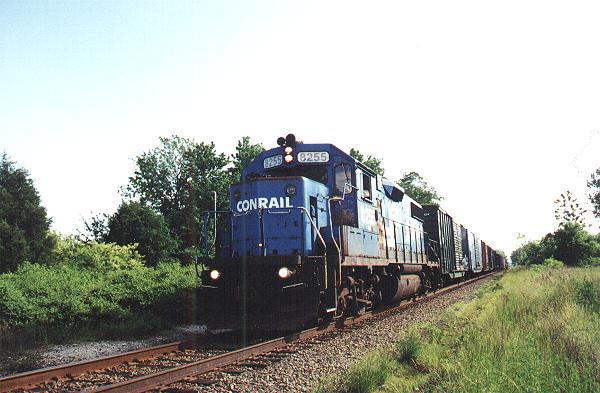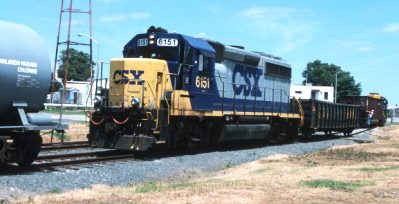| Central Maryland Rail System, Inc. |
| home | About Us | History | System Map | Equipment Roster | Customers | Subsidiaries | Contact Us | MDRAILINKS |
| History |
 The Central Maryland Rail System came to be as a result of the split-up of Consolidated Rail Corp. (Conrail) between Norfolk Southern and CSX Transportation. A little known, little used secondary in the Southern Maryland backwoods was in danger of being abandoned due to the pending merger. Neither of the class I carriers saw any profitability in the line which serviced two power plants and two lumberyards. The officials at the power plants tried desperately to convince CSX and NS that they relied heavily on rail service, and that abandoning the line would cause the local economy to plummet. Neither carrier, however, was interested in maintaining the line.
The Central Maryland Rail System came to be as a result of the split-up of Consolidated Rail Corp. (Conrail) between Norfolk Southern and CSX Transportation. A little known, little used secondary in the Southern Maryland backwoods was in danger of being abandoned due to the pending merger. Neither of the class I carriers saw any profitability in the line which serviced two power plants and two lumberyards. The officials at the power plants tried desperately to convince CSX and NS that they relied heavily on rail service, and that abandoning the line would cause the local economy to plummet. Neither carrier, however, was interested in maintaining the line.
Having heard of the power authorities pleas for help, life-long Maryland Native, D. Curtis, decided to offer a bid on the acquisition of the secondary line and second hand equipment from Conrail in an attempt to maintain access to the power facilities. The power company gave Mr. Curtis considerable financial backing as well as lobbying support in hopes that his efforts would be successful.
If successful, the new railroad would receive inbound coal and/or petroleum products at Benning Yard (which would fall under CSXT control). Amtrak would grant run-through rights on the Northeast Corridor (NEC) between Washington, DC and the Bowie Interchange at Bowie, MD. From the Bowie Interchange to the Brandywine Wye, and from Brandywine southeast to Herbert and south to Morgantown, the new railroad would own, maintain and operate all trackage (approximately 67.8 miles of track). In addition, the new railroad would have exclusive rights to government-owned track that began at the Indian Head Jct. And extended to the Naval Surface Weapons Center in Indian Head, MD. The new railroad would also continue regular rail service to the two lumberyards that depend on rail service for their survival as well.
Money and lobbying efforts from the power company, and massive community support finally paid off. In 1998, Central Maryland Rail was born. The entire employee base would be assimilated from the Conrail employees who were currently working the secondary, and the first train would run in March of 1999. Conrail continued to provide rail service until March 1, 1999.
Following is an abbreviated timeline of events.
| Incorporated : | October 1998. Began construction of yard and operations at Indian Head Jct. The first ex-Conrail acquired locomotives were sent to Huntington Shops for overhaul and a paint job. |
| Ran First Train : |  March 1, 1999. Ex-Conrail GP39-2 pulls the inaugural Central Maryland Rail train into the La Plata Station Siding at La Plata, MD as the last Conrail local heads back to Benning Yard at Washington, DC. March 1, 1999. Ex-Conrail GP39-2 pulls the inaugural Central Maryland Rail train into the La Plata Station Siding at La Plata, MD as the last Conrail local heads back to Benning Yard at Washington, DC. |
| OCT 98 - DEC 98: | Began lobbying efforts to the government for full purchase of the ‘Navy’ tracks (15.0 miles) between Indian Head Jct. and Indian Head, MD. Also submitted a bid to the US Navy to restore active rail service to the NSWC at Indian Head. |
| JAN 99 - MAR 99: | Purchase of the ‘Navy’ tracks was authorized in January, 1999, and a preliminary contract was awarded by the Navy to re-establish rail delivery of coal and other classified commodities to NSWC, Indian Head. Track restoration efforts began on the ‘Navy’ line in February 1999. Central Maryland Rail is approached by the Northern Central Railway Company of New Freedom, PA to establish excursion service on the scenic ‘Navy’ line. An agreement is reached in March 1999. |
| APRIL 1999: |  Central Maryland Rail purchases the 7.1 mile Shepard Industry Track (Benning Yard to Blue Plains, Washington, DC) from CSX Transportation. In doing so, renews an agreement with the water treatment plant, at the end of the line, to continue delivery of chemicals for sewage treatment. Central Maryland Rail purchases the 7.1 mile Shepard Industry Track (Benning Yard to Blue Plains, Washington, DC) from CSX Transportation. In doing so, renews an agreement with the water treatment plant, at the end of the line, to continue delivery of chemicals for sewage treatment. |
| MAY 1999: | Wins an Army contract to provide rail service to Aberdeen Proving Grounds at Aberdeen, Maryland, and the Army Chemical Center at Eagle Point, MD. Officially establishes the Government Operations Division (GovOps). |
| JUNE 1999: | Purchases several ‘as is’ locomotives from CSX and NS, and contracts EMD to restore the units to service. Amended the construction at Indian Head Jct. to include in-house locomotive and car maintenance facilities. Began intense PR efforts in the Charles County, MD area in order to drum up more potential rail customers. |
| JULY 1999: | After only a few weeks of effort, signed up four new rail customers with a fifth pending (seeking restoration of abandoned trackage to the river pier at Pope’s Creek). Received National attention for its rapid growth and boost to the local economy. Received hundreds of investment inquiries from local and national interests. Received an invitation from the Baltimore Port Authority to operate and maintain ex-Western Maryland facilities at Winan’s Cove for service to smaller, independent importers. |
| AUGUST 1999: | Assumes control of Winan’s Cove and forms the Maryland Inland Terminal. Changes name of company to Central Maryland Rail Systems and distinguishes operations between freight services (MDRail) and terminal services (MDIT). Establishes agreement with CSX to interchange independent Intermodal loads at Baltimore (via MDIT) and Philadelphia (via MDRail). |
| SEPTEMBER 1999: | Begins contacting other port authorities between Richmond and New Orleans to bid for independent shipper service contracts. HQ facilities officially open at Indian Head Jct. All equipment maintenance activities are removed from contractors and transferred to in-house – MDRailshops is established. Lobbied the Commonwealth of Virginia for the acquisition of what remained of the ex- RF&P Potomac Yard (to minimize growing traffic congestion at Benning Yard). |
| OCTOBER 1999: | CMRS recognized Nationally for record-setting growth; In spite of unorthodox spending habits over the first year of operations, announces a profit after one year (no other local or regional railroad has accomplished this ever). |
| Fiscal Year Ending September 30, 2001: | Operates 1838 miles of owned/leased track; Owns 456 locomotives (delivered); owns/leases 5472 freight cars; 6.8 million tons of total freight carried; Net profit of $20.3 million earned. |

